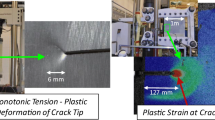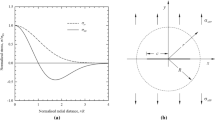Abstract
The fatigue and fracture performance of a cracked plate can be substantially improved by providing patches as reinforcements. The effectiveness of patches is related to the reduction they cause in the stress-intensity factor of the crack. Hence, an accurate evaluation of SIF in terms of various parameters is required for reliable patch design.
In this paper, the influence of patch parameters on the opening-mode stress-intensity factor for a plate with a central crack is studied by employing transmission photoelasticity. Cracked plates made of photoelastic material are patched on one side as well as both sides by epoxy, phenolic and E glass-epoxy composite materials. The patch is located on the crack in such a way that the crack tip is not covered. Magnified isochromatic fringes are obtained by using a projection microscope of 50 magnification, converted into a polariscope. Irwin's method with extrapolation is employed to compute the stress-intensity factor from photoelastic data. The reduction in the stress-intensity factor is presented in graphic form as a function of pathch parameters, namely stiffness, width and length.
Similar content being viewed by others
Abbreviations
- a :
-
semi crack length (Fig. 1)
- b :
-
semi width of plate (Fig. 1)
- E :
-
Young's modulus of plate
- E p :
-
Young's modulus of patch in the loading direction
- f σ :
-
material fringe value
- K AP :
-
apparent SIF
- K I :
-
stress-intensity factor (SIF) of plate in opening mode
- K IP :
-
SIF of plate with patch
- \(\bar K\) :
-
K IP/KI
- l :
-
semi length of plate (Fig. 1)
- l p :
-
semi length of patch
- N :
-
fringe order
- t :
-
thickness of plate (Fig. 1)
- t p :
-
thickness of patch (Fig 1)
- w :
-
width of patch (Fig. 1)
- σ:
-
uniformly distributed stress at cross section away from crack
- α:
-
patch-stiffness parameter,E ptp/Et
- β:
-
E p/E
- η:
-
patch efficiency\((1 - \bar K)\)
- τ m :
-
the maximum shear stress
References
“Damage Tolerance and Fatigue Evaluation of Structure,” 14 FCR Part 25, 571 (1977).
“Airplane Damage Tolerance Requirement,” MIL Spec., 83444, USAF (1974).
Baker, A.A. and Hutchinson, M.M., “Fiber Composite Reinforcement of Cracked Aircraft Structures,” Tech. Memo. ARL/MAT., 366 (Aug. 1966).
Baker, A.A., “A Summary of Work on Application of Advanced Fiber Composites at ARL Australia,”Composites,9 (1),11–16 (Aug.1978).
Chandra, R., Murthy, M.V.V., Ramamurthy, T.S. andRao, A.K., “Analytical Estimation of Stress Intensity Factors in Patched Cracked Plates,”Eng. Fract. Mech.,21,479–494 (1985).
Subramanian, A., Chandra, R., Murthy, M.V.V. andRao, A.K., “Photoelastic Determination of Stress Intensity Factors in Patched Cracked Plates,”Eng. Fract. Mech.,18,305–313 (1983).
Chandra, R. andSunder, R., “Fatigue Crack Growth in Patched Plates under Constant Amplitude and Flight Simulation Loadings,” Advances in Fracture Research, Proc. 6th Int. Conf. on Fract., New Delhi, India,5,3523–3532 (1984).
Chandra, R., “A Study on Cracked Plates with Composite Patch Reinforcements,” PhD Thesis, Dept. of Aero. Eng., Indian Institute of Science (1986).
Chandra, R. andGuruprasad, K., “Numerical Estimation of Stress Intensity Factors in Patched Cracked Plates,”Eng. Fract. Mech.,27 (5),559–569 (1987).
Post, D., “Photoelastic Stress Analysis for an Edge Crack in a Tensile Field,”Proc. SESA,12 (1),99–116 (1954).
Wells, A. andPost, D., “The Dynamic Stress Distribution Surrounding a Running Crack—a Photoelastic Analysis,”Proc. SESA,16, (1),69–92 (1958).
Irwin, G.R., discussion of Ref. 11, Proc. SESA,16 (1),93–96 (1958).
Bradley, W.B., “A Photoelastic Investigation of Dynamic Brittle Fracture,” PhD Thesis, Univ. of Washington (1969).
Etheridge, J.M. andDally, J.W., “A Critical Review of Methods for Determining Stress-intensity Factors from Isochromatic Fringes,”Experimental Mechanics,17 (7),248–254 (1977).
Smith, C.W., “Use of Three Dimensional Photoelasticity and Progress in Related Area,”Experimental Techniques in Fracture Mechanics, ed. A.S. Kobayashi,2,2–58 (1975).
Smith, D.B. andSmith, C.W., “Photoelastic Determination of Mixed Mode Stress Intensity Factors,”Eng. Fract. Mech.,4,357–366 (1972).
Smith, C.W., Peters III, W.H. andKriby, G.C., “Crack-tip Measurements in Photoelastic Models,”Experimental Mechanics,22 (12),448–453 (1982).
Rooke, D.P. andCartwright, D.J., “Compendium of Stress Intensity Factors,”HMSO, London (1976).
Author information
Authors and Affiliations
Rights and permissions
About this article
Cite this article
Chandra, R., Subramania, A. Stress-intensity factors in plates with a partially patched central crack. Experimental Mechanics 29, 1–5 (1989). https://doi.org/10.1007/BF02327773
Received:
Accepted:
Issue Date:
DOI: https://doi.org/10.1007/BF02327773




